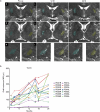Phase I/II trial of iPS-cell-derived dopaminergic cells for Parkinson's disease
- PMID: 40240591
- PMCID: PMC12095070
- DOI: 10.1038/s41586-025-08700-0
Phase I/II trial of iPS-cell-derived dopaminergic cells for Parkinson's disease
Abstract
Parkinson's disease is caused by the loss of dopamine neurons, causing motor symptoms. Initial cell therapies using fetal tissues showed promise but had complications and ethical concerns1-5. Pluripotent stem (PS) cells emerged as a promising alternative for developing safe and effective treatments6. In this phase I/II trial at Kyoto University Hospital, seven patients (ages 50-69) received bilateral transplantation of dopaminergic progenitors derived from induced PS (iPS) cells. Primary outcomes focused on safety and adverse events, while secondary outcomes assessed motor symptom changes and dopamine production for 24 months. There were no serious adverse events, with 73 mild to moderate events. Patients' anti-parkinsonian medication doses were maintained unless therapeutic adjustments were required, resulting in increased dyskinesia. Magnetic resonance imaging showed no graft overgrowth. Among six patients subjected to efficacy evaluation, four showed improvements in the Movement Disorder Society Unified Parkinson's Disease Rating Scale part III OFF score, and five showed improvements in the ON scores. The average changes of all six patients were 9.5 (20.4%) and 4.3 points (35.7%) for the OFF and ON scores, respectively. Hoehn-Yahr stages improved in four patients. Fluorine-18-L-dihydroxyphenylalanine (18F-DOPA) influx rate constant (Ki) values in the putamen increased by 44.7%, with higher increases in the high-dose group. Other measures showed minimal changes. This trial (jRCT2090220384) demonstrated that allogeneic iPS-cell-derived dopaminergic progenitors survived, produced dopamine and did not form tumours, therefore suggesting safety and potential clinical benefits for Parkinson's disease.
© 2025. The Author(s).
Conflict of interest statement
Competing interests: N.S., R.T. and J.T. received a grant for collaborative research from Sumitomo Pharma. R.T. received a research grant from Nihon Medi-Physics. T.O. received a research grant from Siemens Healthcare. S.H. is an employee of Sumitomo Pharma. The other authors declare no competing interests.
Figures









References
-
- Kordower, J. H. et al. Neuropathological evidence of graft survival and striatal reinnervation after the transplantation of fetal mesencephalic tissue in a patient with Parkinson’s disease. N. Engl. J. Med.332, 1118–1124 (1995). - PubMed
-
- Piccini, P. et al. Dopamine release from nigral transplants visualized in vivo in a Parkinson’s patient. Nat. Neurosci.2, 1137–1140 (1999). - PubMed
-
- Barker, R. A., Barrett, J., Mason, S. L. & Bjorklund, A. Fetal dopaminergic transplantation trials and the future of neural grafting in Parkinson’s disease. Lancet Neurol.12, 84–91 (2013). - PubMed
-
- Freed, C. R. et al. Transplantation of embryonic dopamine neurons for severe Parkinson’s disease. N. Engl. J. Med.344, 710–719 (2001). - PubMed
-
- Olanow, C. W. et al. A double-blind controlled trial of bilateral fetal nigral transplantation in Parkinson’s disease. Ann. Neurol.54, 403–414 (2003). - PubMed
Publication types
MeSH terms
Substances
LinkOut - more resources
Full Text Sources
Medical
Miscellaneous

